Sunderland: A huge Premier League club that came across major issues on and off the pitch and before you knew it, were a fallen giant in the EFL League One. League One is an especially difficult division to get out of but last season, Sunderland finally achieved that via the playoffs, becoming a Championship club again for the first time since 2017/18. A big club with big ambitions, they finally cracked the code to gaining promotion last season and haven’t slowed down in the Championship this season either.
At the time of writing, the Black Cats sit in 10th place, just three points off the playoffs after 27 games. Their form has been inconsistent for a considerable chunk of the season, but they are still in contention to qualify for the playoffs for promotion to the Premier League come the end of matchday 46. As we see almost every season, the transition from League One to the Championship can often be an extremely difficult task, but Sunderland boss Tony Mowbray’s immense experience seems to be paying off. Mowbray’s experience and game management have been important factors in Sunderland’s recent success, with the Middlesborough legend placing his faith in 3-4-3 and 4-2-3-1 as his primary formations.
In this scout report, we will provide a tactical analysis of some of the key areas of Mowbray’s side, looking at why they have been able to adapt to life in the Championship so well. There will be an analysis of how they press in certain areas, along with a discussion on their attacking assets as well, including ball progression.
Pressing in midfield and high areas
As you would expect from a Tony Mowbray side, Sunderland work very hard on and off the ball, looking to get things done swiftly. They aren’t a side to sit back and soak up the pressure, but they are particular about their timing in a press — they seem to have struck gold with their tactics off the ball, pressing in midfield and high areas when the opponent presents a pressing trigger.
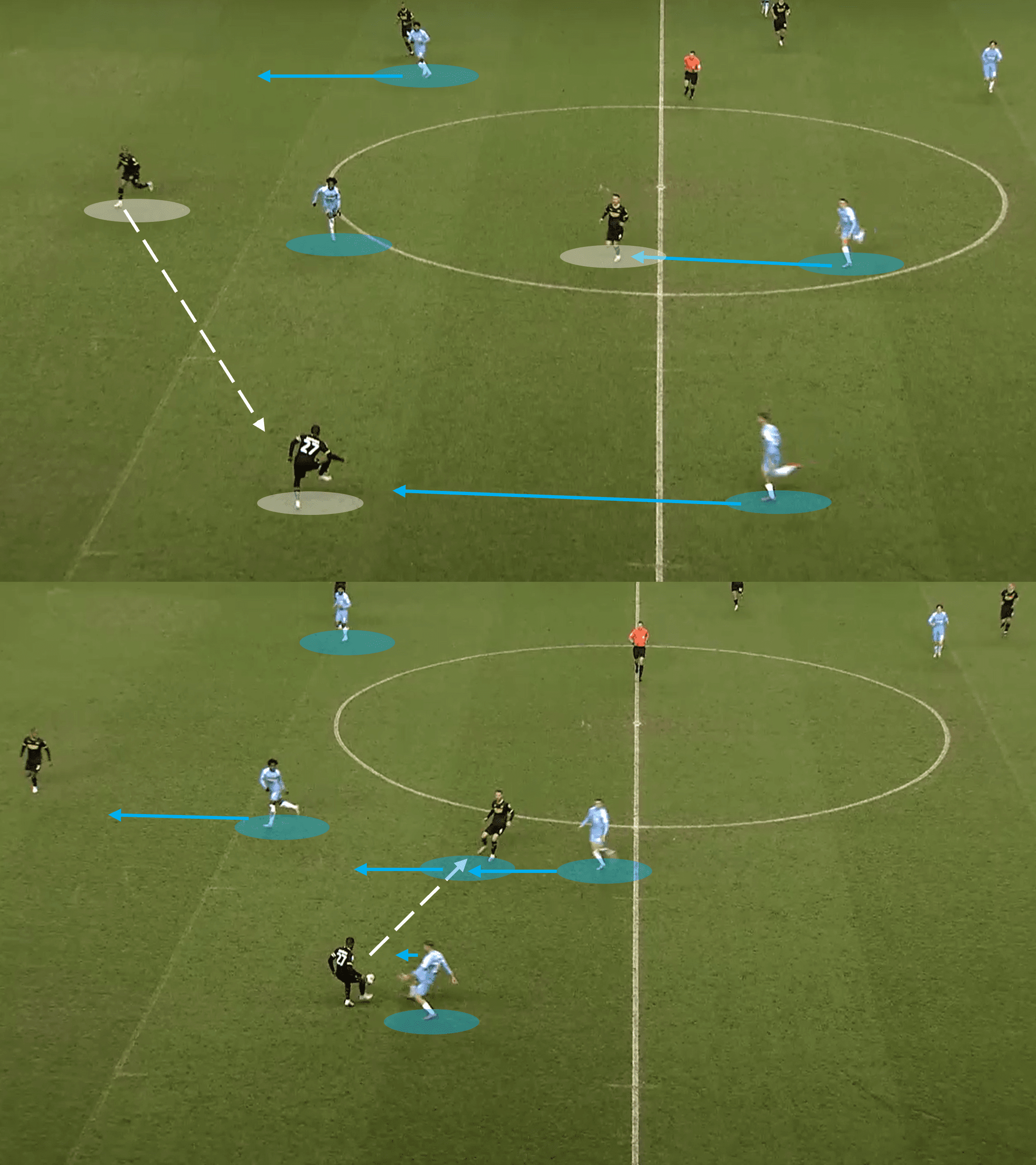
This first analysis provides a good example of Sunderland’s ability to recognise pressing triggers and how they react positively to them. Wigan Athletic look to try and play through the Sunderland midfield, but a less-than-satisfactory pass and a heavy control of the ball meant that the Latics weren’t in full control of the ball, allowing Sunderland’s close midfield unit to squeeze the space.
The closest man would press the player on the ball, forcing him into making a pass to the closest teammate. However, Sunderland’s clever set-up and quick thinking mean that they have a man closing in fast on the new recipient of the ball. The ball is turned over as the pass is played due to Wigan having no room or time to rectify the situation. Often, when Sunderland are successful in a press like this, they waste no time in breaking forward, driving at the opposition defence with the midfield often in temporary disarray.
An interesting element of Sunderland’s press, which is often present but particularly so in the example above is the anticipation of the attacking player — in this case, Ellis Simms. He is already making a run through the opposition defence just before his team regains possession. This clever awareness gives Sunderland more options going forward when they do win the ball in these areas.
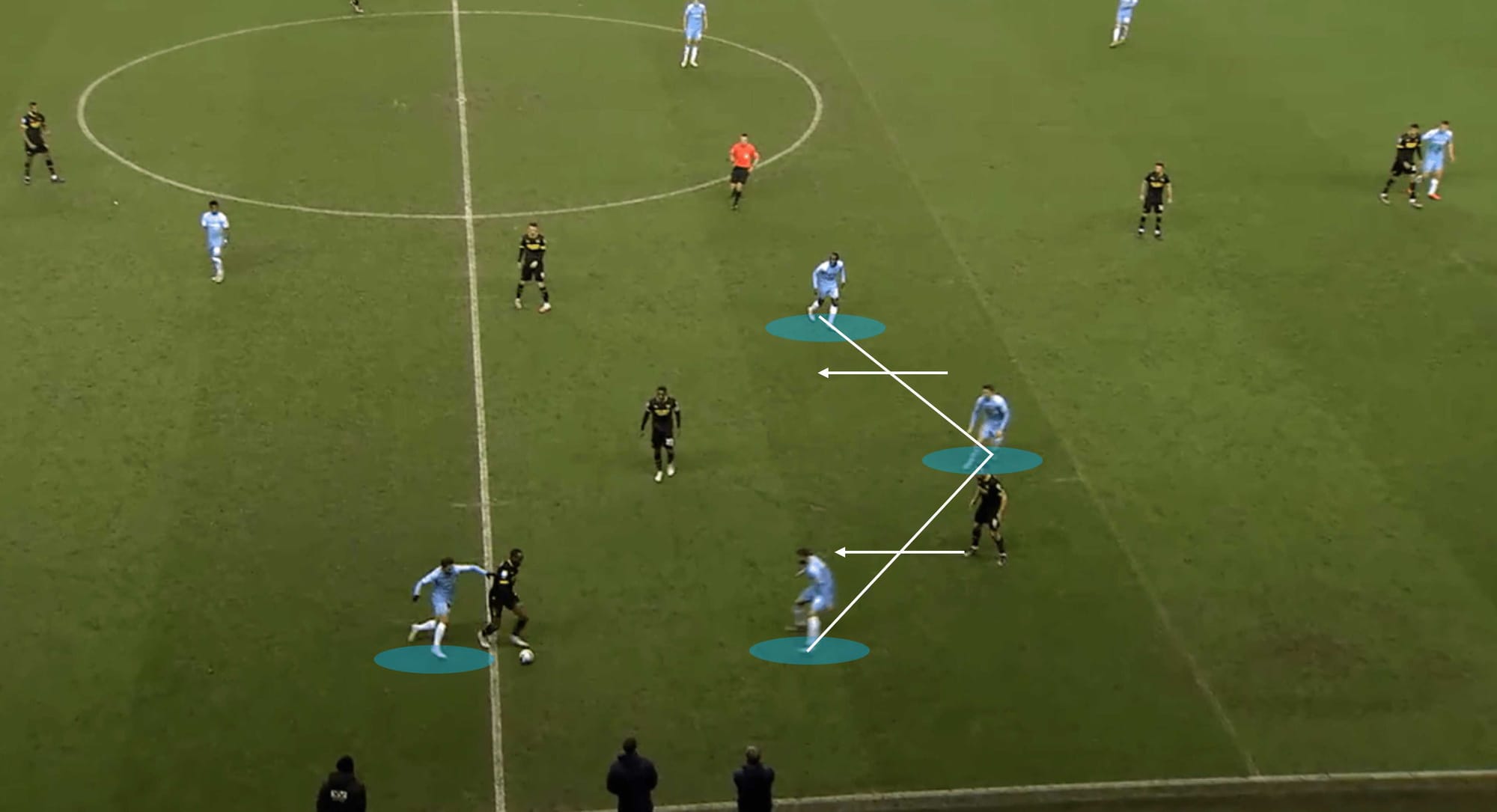
Here we have another example of Sunderland pressing in midfield areas but with a slightly different approach. Their midfield is already set up in a shape designed to rush the opponent and force a mistake out of them. Had the Wigan player not been pressed by the Sunderland winger, he may have had the composure to play the pass to his free teammate inside, but due to the pressure on him, he makes a poor decision and tries to play a pass down the line.
While the poor Wigan pass is an important part of the turnover in this example, it also speaks volumes about Sunderland’s organisation. They again stepped up to squeeze the space between their unit and the opponent on the ball, giving him very little to aim for. What’s also clever is that when
Sunderland do win the ball thanks to this compact squeeze, it means they have three or four passing options close by to move the ball quickly.
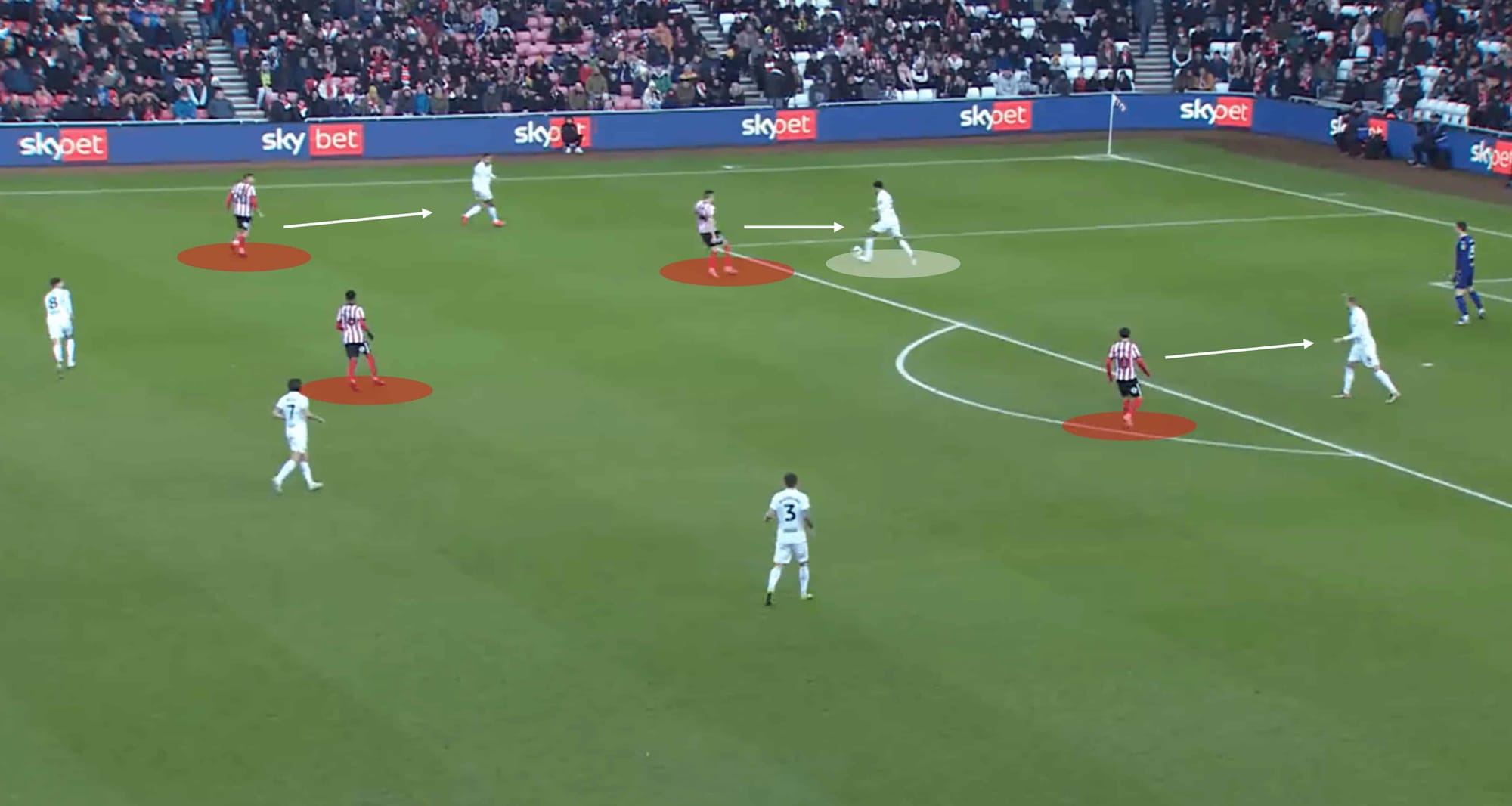
When the appropriate game situation presents itself, Sunderland will press in high areas as well. Factors like match time and scoreline are factors, but so too is the opponent — if Sunderland sense that the opposition aren’t comfortable on the ball at the back on the day, they will set up in a shape with the aim of stopping the opponent playing out, either forcing them into playing a long ball or simply winning the ball back.
The example above demonstrates these tactics nicely. Sunderland mark the passing options on either side of the man on the ball while he too is pressed. Behind that there will be a midfielder screening the area, looking to intercept any attempted passes that come through his area. Behind him (out of shot) will often be more midfielders protecting the space behind. With several teams in the Championship not accustomed to playing out of the back under pressure, this is a clever use of a high press from Mowbray, and it is clear to see that his players have a strong understanding of his tactics as well.
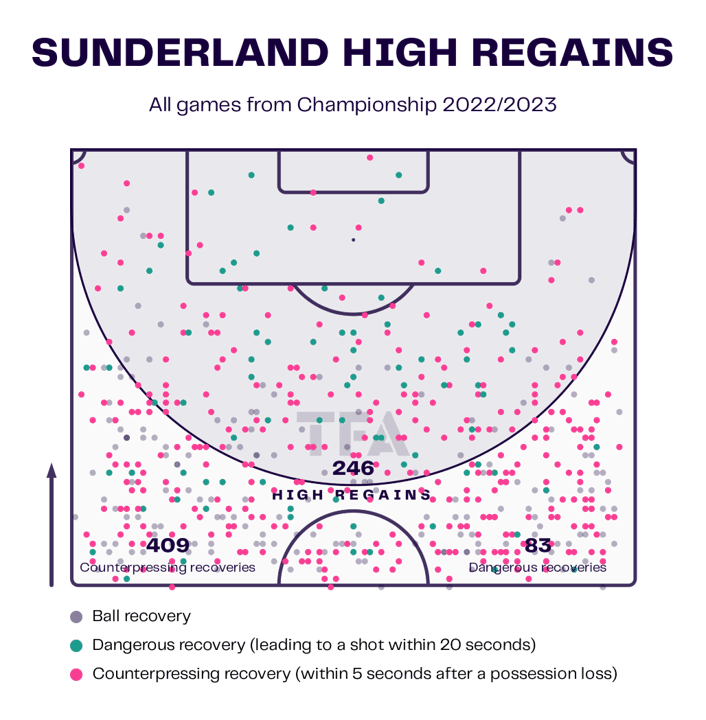
Winning the ball back in the opponent’s half is a key element of Sunderland’s tactics, and it goes hand-in-hand with the quick ball progression. This season, they have so far won the ball a whopping 409 times in the opposition half, with 246 of those coming in the shaded area in the image above — the final third, with 83 of those recoveries leading to a shot within 20 seconds of winning the ball back. Sunderland are a high-energy team in key moments who have displayed the ability to make it count.
Quick Ball Progression
As we mentioned in the previous analysis segment, Sunderland are a team that look to get things done quickly — quick thinking and decision-making followed by swift execution. This is likely why we rarely see them dominate a game in terms of possession, as they aim to gain yards up the pitch the second they get the ball. So far this season, the Black Cats have an average of 51.04% possession per 90 minutes, so their fixtures are often fairly even in terms of ball possession, but they average nearly 10 more forward passes per 90 than their opponents (137.44 for Sunderland).
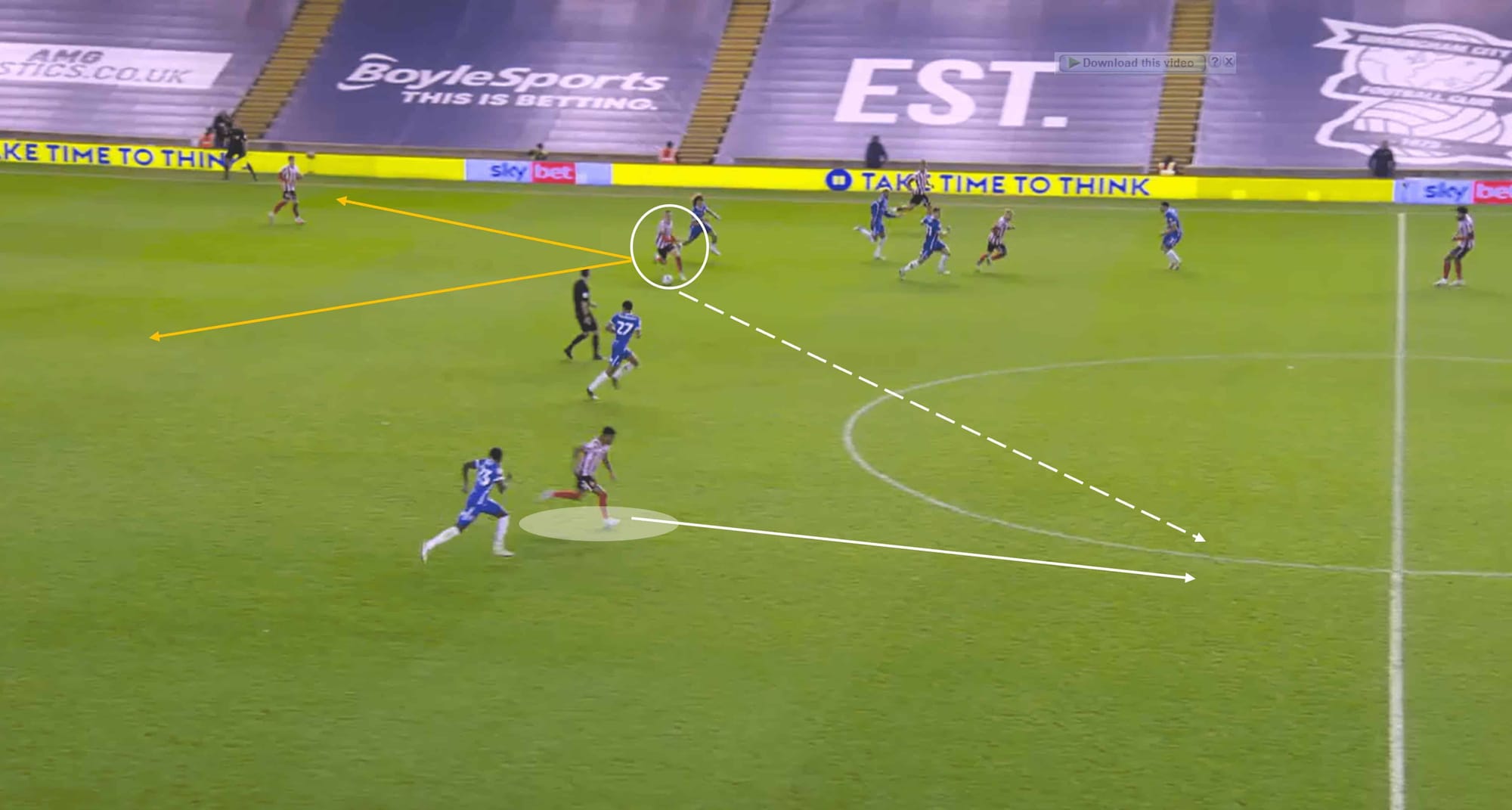
This first analysis of Sunderland playing forward quickly is a simple yet very effective one. Occurring during a transition with Sunderland taking the ball away from danger on their left side of the pitch, many of the opposition players are located towards that side, leaving more space on the right.
While the pass into the open space looks like an obvious one, the timing, weight, and accuracy of the pass were spot-on and allowed the Sunderland man to drive forward into the opposition box before curling a shot past the keeper.
How is this significant to Sunderland’s approach play? As covered, their first thought is to move the ball forward quickly, rarely interested in keeping the ball for the sake of possession. For example, where Sunderland played that pass into space, we’d see many other clubs slow the game down and play a safe backwards pass, but this would only allow the opposition to regain shape.
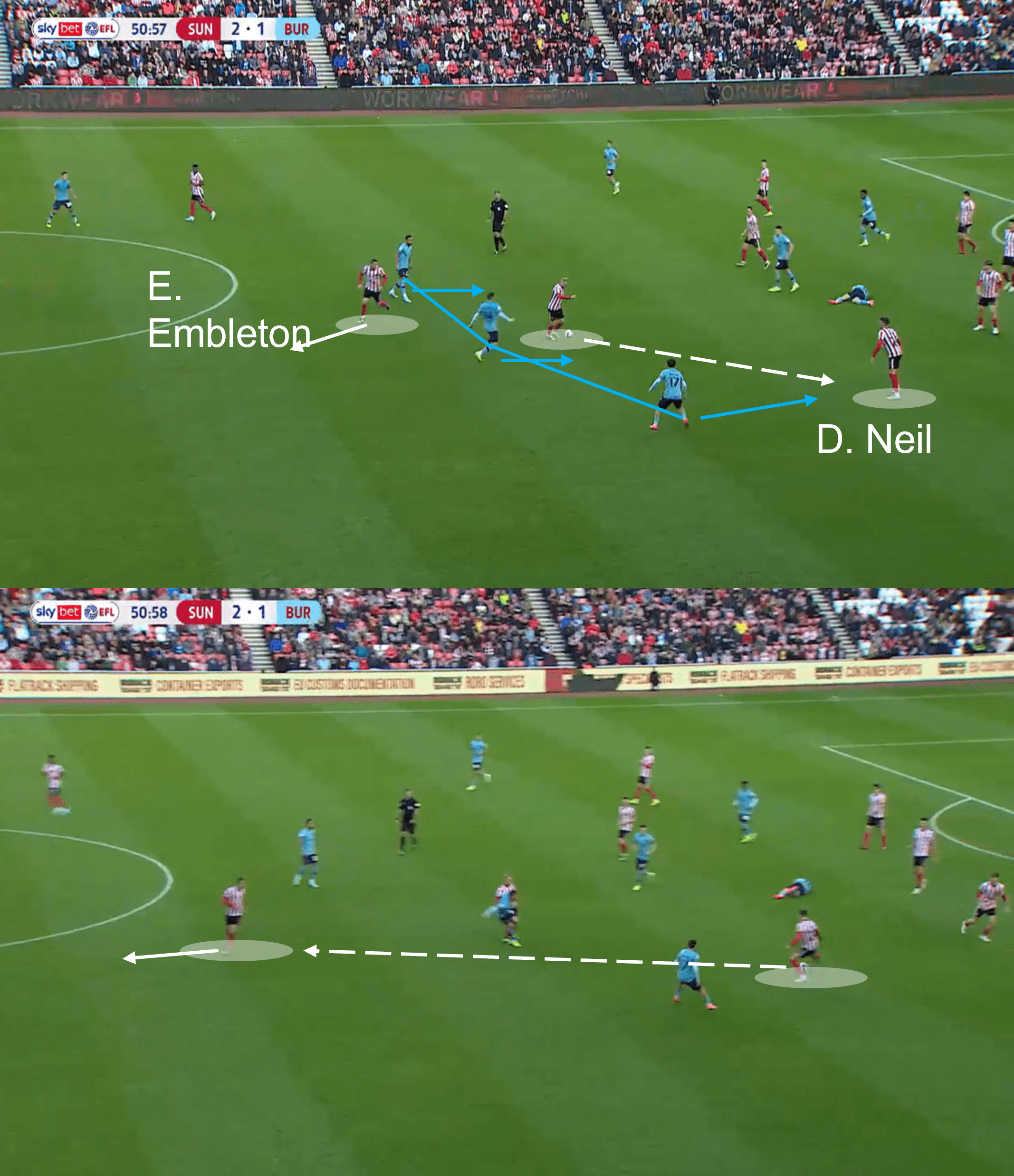
Moving the ball forward quickly isn’t always about killer through balls, it also relates to getting out of dangerous situations to make progress up the pitch. Alex Pritchard is the man on the ball facing his own in the first of the two images above, with Dan Neil offering close support in a good position. Neil recognises that the closing opposition midfield unit is closing in, looking to apply a unit press to force Sunderland into a mistake.
This is where credit goes to Sunderland, and Dan Neil in particular, as he shows good awareness, vision, and composure to thread the ball through that opposition midfield unit into Elliot Embleton. Embleton also deserves credit in this scenario, as he too recognises the opposition midfield press, and uses the space they left behind them to make his own, giving himself a perfect area to receive the ball from Neil.
This combination was executed with composure, quality and speed. This allowed Sunderland to break out of their defensive third and into the spacious midfield zone; they would have likely gone on to create a dangerous chance on goal if Embleton wasn’t fouled upon entry to the midfield third.
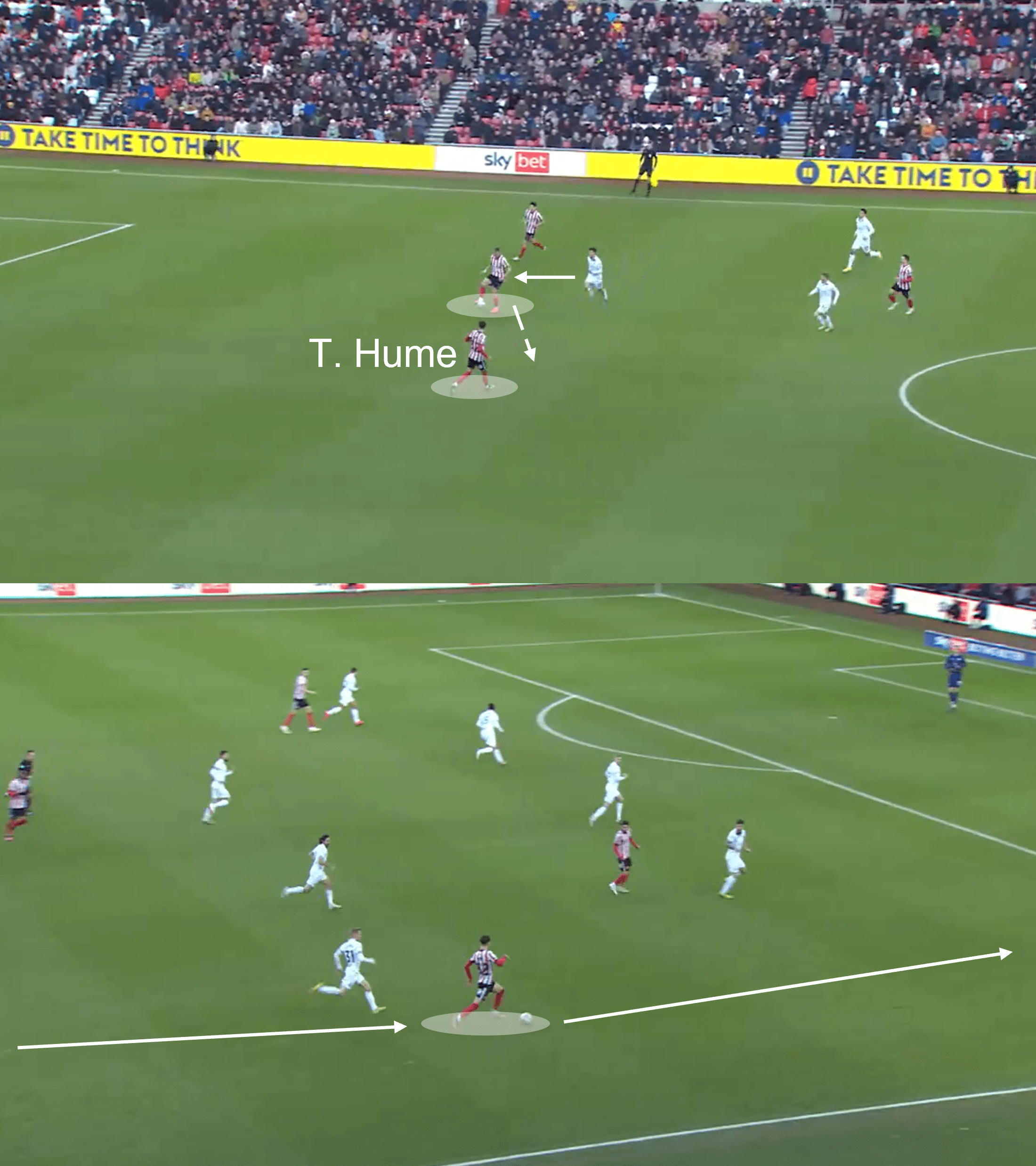
Through balls, long passes, and passing combos are three very effective ways of progressing up the pitch quickly, but so is driving forward with the ball and covering large yardage in a small amount of time, which is exactly what Trai Hume brings to the table. Instead of steadily progressing into the midfield third before playing a pass that leans towards a more possession-based approach, he makes an incredible burst from his own half all the way to the opposition box, showing good speed and impressive ball control along the way, before firing a low cross into the box towards the edge of the area. While the attack did not lead to a goal, Hume was able to turn possession in his own half into a chance on goal simply by driving forward and getting his team into the final third quickly.
Danger from wide areas
Truthfully, Sunderland don’t seem to be married to one particular style of play. Their tactics centre around moving the ball quickly, making the most of transitions, and taking advantage of spaces left by opponents, so there is an element of fluidity and unpredictability about their attacking approach.
However, naturally, this sees them utilising the wings fairly often, and they have demonstrated a good ability to cause harm from these areas. As you will see in the analysis that follows, their wide play isn’t just about launching crosses into the box, but about build-up play with combinations in those wide areas to try and open up a chance on goal.
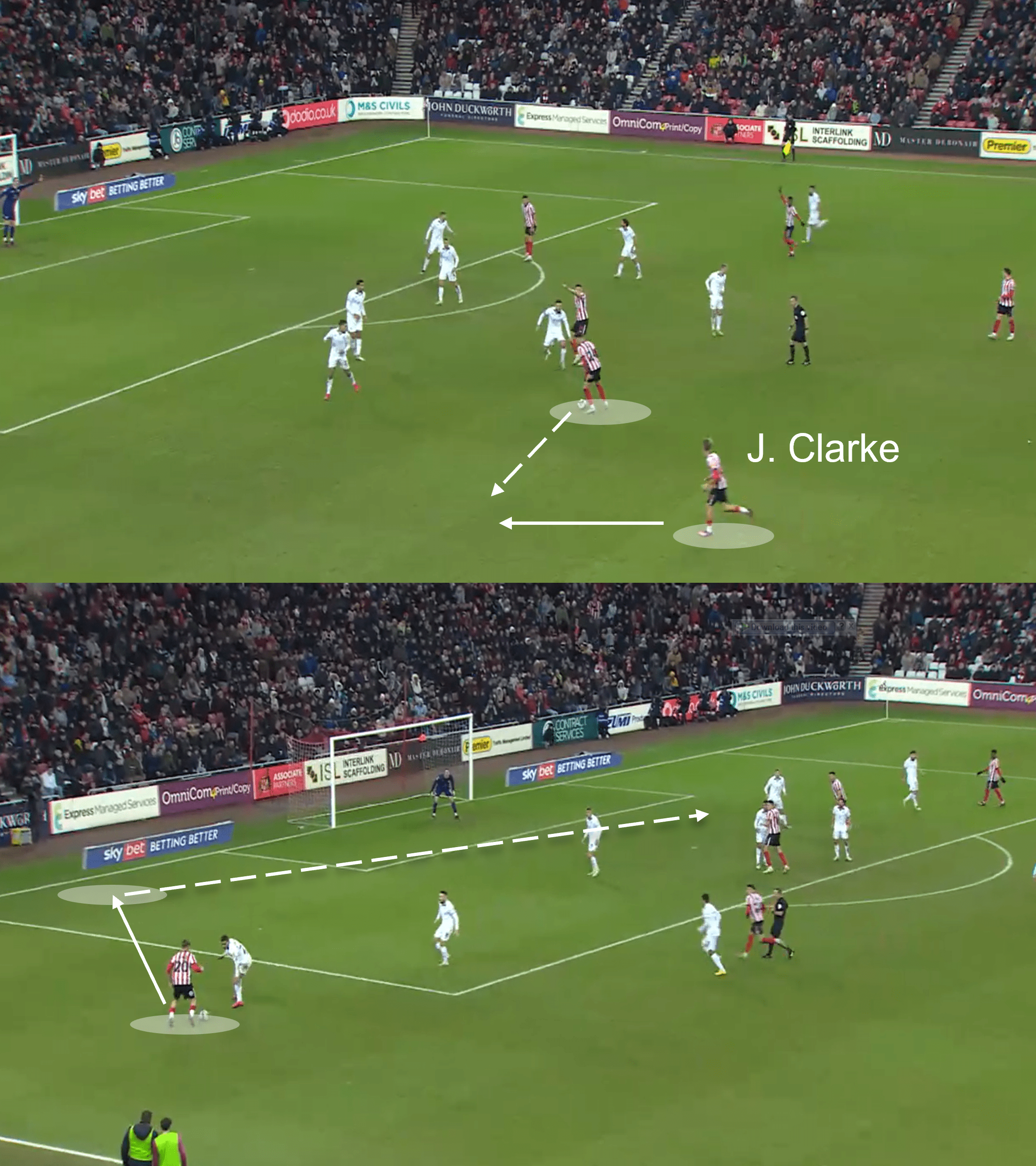
While Sunderland, like all teams, have spells of possession in the opposition half, their width in attack seems inconsistent, which can often throw the opponent off. For example, the example above shows Mowbray’s side attacking a deep opposition with plenty of players behind the ball, but Sunderland aren’t hugging both touchlines. If they adopted that shape every time they had the ball, opponents would be able to anticipate it and give themselves a better chance of defending the attack. Instead, Sunderland transition into wide areas to utilise the space out there, as their opponents won’t be defending wide if there’s nothing to defend.
Tottenham loanee Jack Clarke starts the move in a deep position just off-centre, but begins to drift slightly wider as the pass from the middle meets him. Here is where is important to understand what we mentioned previously about Mowbray’s attacking tactics relying on attacking spaces and individual impact, as Clarke shows brilliant technical talent to win his 1v1 against the opposition full-back.
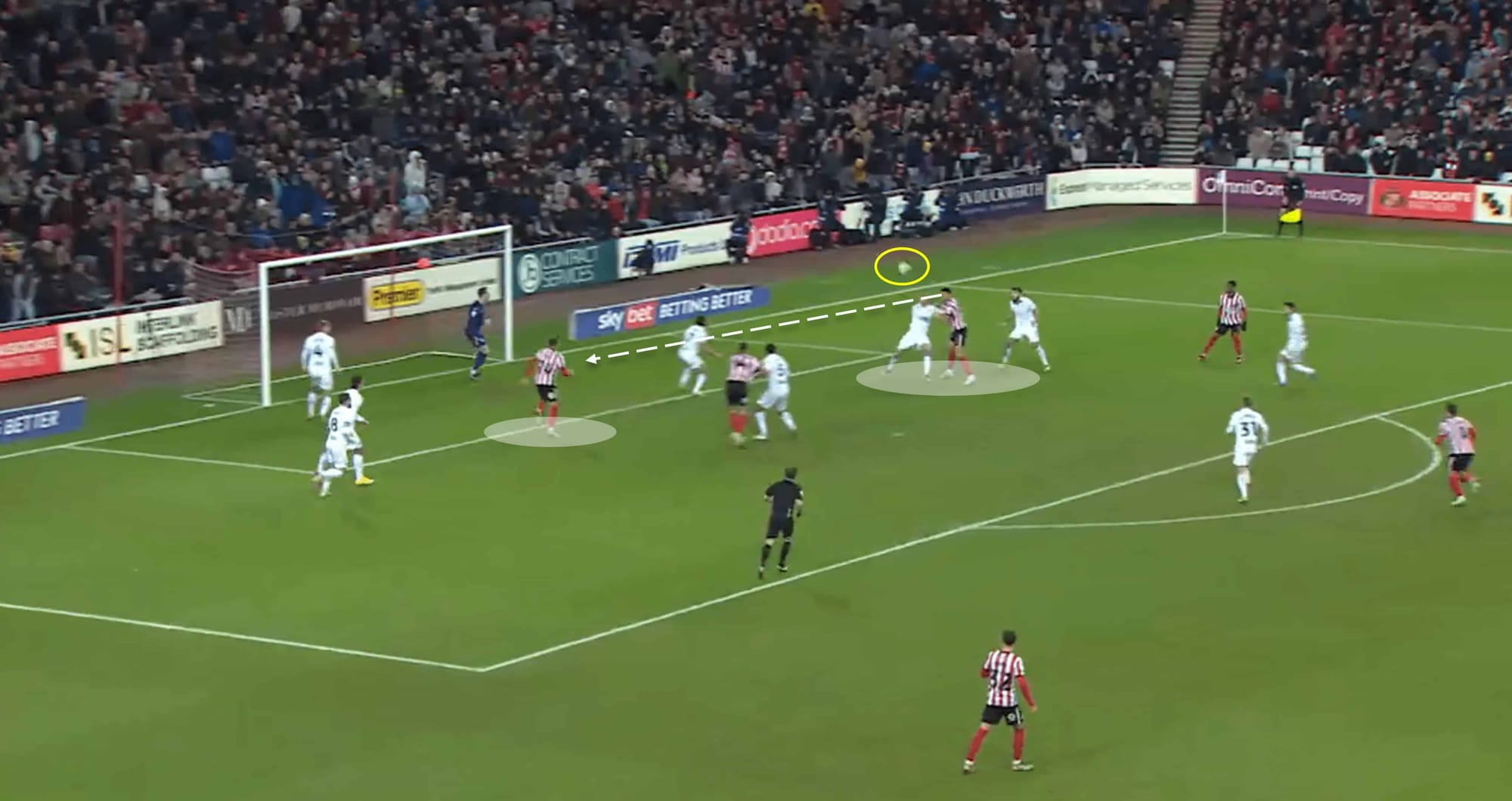
Upon reaching the byline, Sunderland’s presence in the box should’ve been a tip-off to the opponent as most of the Black Cats’ attackers are located toward the far side of the box. The cross is a quality one, floated toward the far side, where a cushioned header back across goal finds a red and white shirt.
Dan Neil is the highlighted Sunderland player in the middle, and he showed good awareness and reactions to make the run into that space between the opposition defenders and into the path of the ball. He is unmarked and can head the ball home, wrapping up a very incisive and clinical Sunderland move.
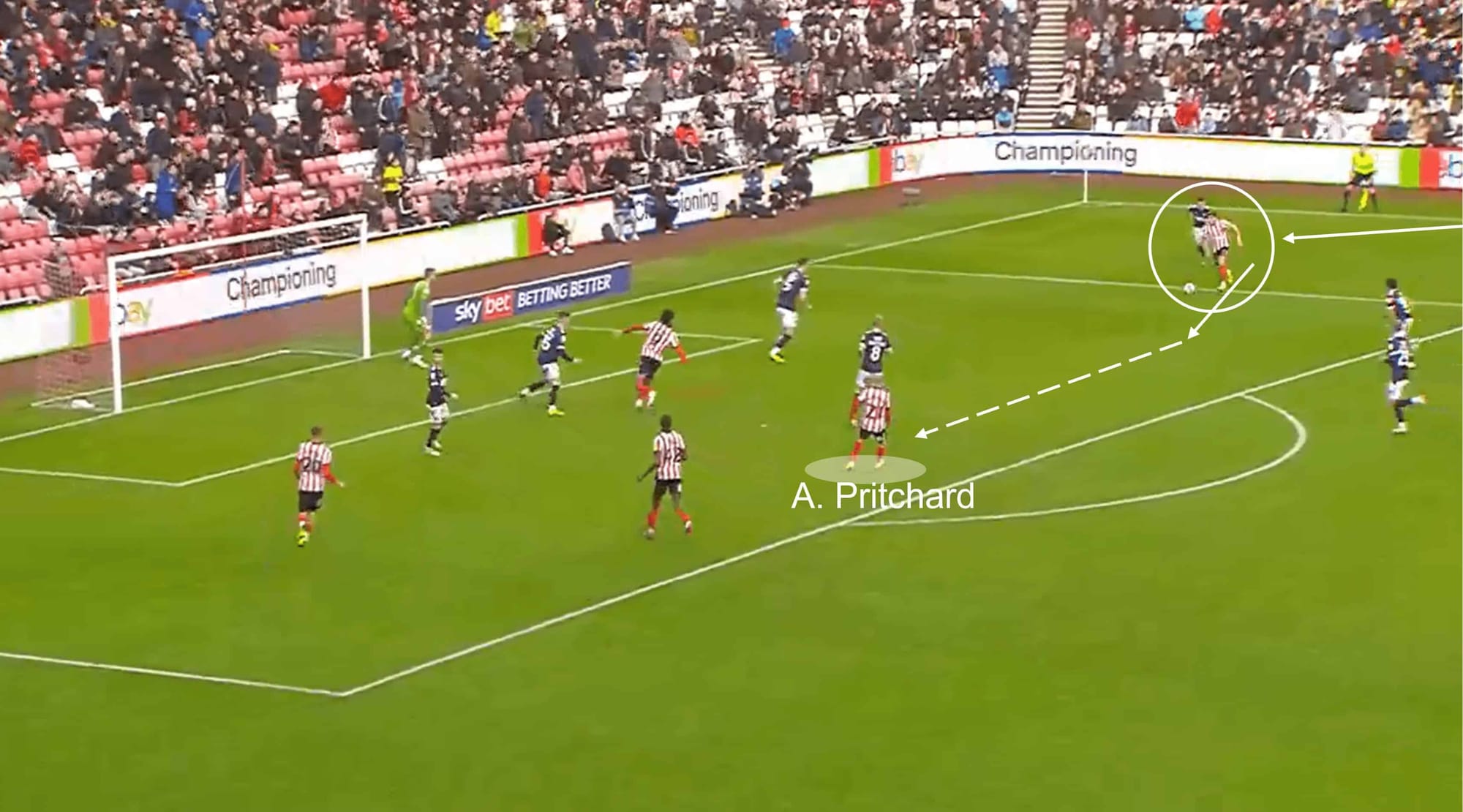
Here, we have another example of attacking from wide areas, but this one doesn’t involve a cross. After Sunderland play a quick pass down the right flank for the winger to collect, he cuts inside to cleverly beat the opposition full-back. He then looks to find a teammate but avoids simply floating the ball into the box.
While we could pick apart the Millwall defensive positioning, and boy could we, the focus here is on Sunderland turning possession out wide to dangerous possession inside the box. Pritchard scans the area and drifts away towards the edge of the box, which is where he collects the ball. He then shows exceptional technical ability to drive past three approaching defenders before slamming the ball into the goal. There could be an argument for Millwall expecting an early cross due to the Sunderland presence in the box, but the Black Cats again take advantage of spaces left by the opponent.
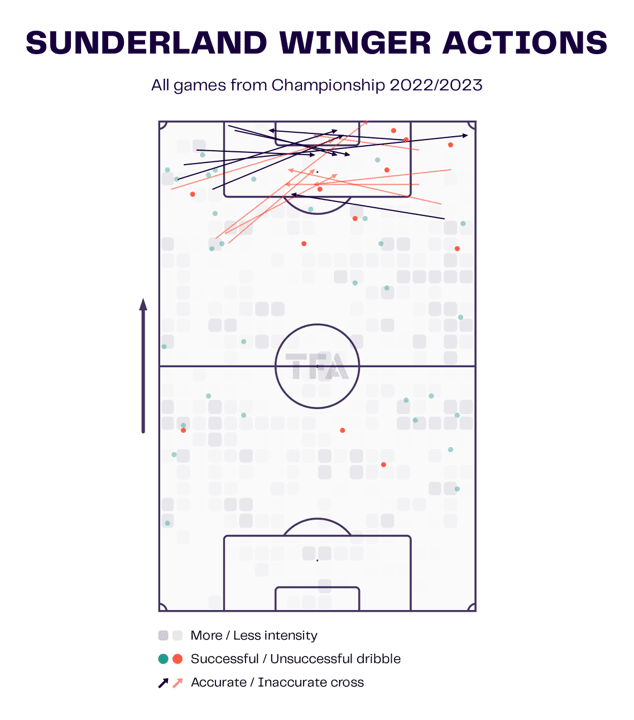
This image summarises our point about Sunderland’s attacking tactics in wide areas: wing play isn’t a staple of their system, just a factor of it, coming into play when the chance presents itself. They aren’t a team to simply launch cross after cross into the box, especially from the right flank, but they do seem to cause damage from the left flank when crossing from the byline.
Conclusion
Sunderland could be a dark horse in the playoff picture this season. They have all the tools needed to qualify in the top six, with a manager capable of achieving such a feat, but if anything is to stand in the way of promotion, it is their record against their promotion rivals.
This season, they have so far fallen to defeats against Burnley, Middlesborough, Sheffield United, and Norwich City to name a few, so finding a better balance in those games will be key. Their tactics in attack add an element of unpredictability due to the fluidity and pace of their approach, which can be hard for teams to defend against; if Sunderland do earn promotion, it will likely be thanks to their attacking assets rather than their defensive record.






Comments